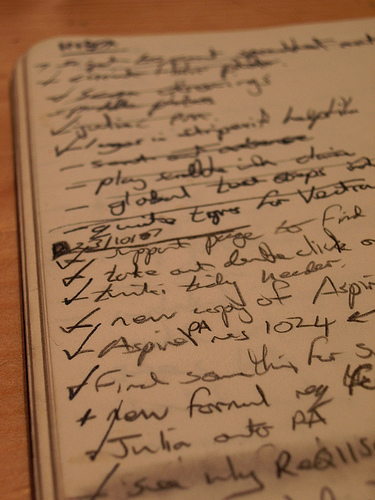 Task lists can help you get a ton of things done and give you peace of mind–but usually don’t. The average task list feels less like a train flying down the tracks of productivity and more like a train you missed, a train that’s going somewhere you don’t want to be, or a train wreck. Why? Here are the five main reasons.
Task lists can help you get a ton of things done and give you peace of mind–but usually don’t. The average task list feels less like a train flying down the tracks of productivity and more like a train you missed, a train that’s going somewhere you don’t want to be, or a train wreck. Why? Here are the five main reasons.
1. The list isn’t really easy to get to and use
If you can’t pull up your task list in less than 30 seconds and easily update it, you’ll probably be too busy actually doing things to keep messing around with it. For a task list to be truly useful, it has to be easily accessible everywhere you might want to use it, and it has to be very easy to find, add, change, and check off items. Otherwise it’s a constant burden and an interruption, and it takes enormous effort to keep up with a habit like that.
Find a tool for tasks you love that’s available where you need it. Since I’m almost always near a computer, I like the free service called Todoist.
2. Not everything is on it
If you keep some of your tasks in your task list but others in other places–like sticky notes on your computer, scribbles on pieces of paper, or even physical reminders like leaving out something you need to fix instead of putting it on your list–then you can’t trust your list to tell you what you should be doing at all times, which is its job. An effective task list needs to have everything you need to do on it. This requires getting in the habit of immediately going to your task list to add a task whenever you promise to do something, think of something you need to attend to, receive something in the mail you have to respond to, etc.–or make sure all of your tasks get written down and use the paper management approach I talk about in this post about how to handle incoming paper and this post about organizing and filing.
3. It doesn’t get reviewed regularly
If you put things on your task list and then avoid looking at it again, then it won’t be up to date or useful. If you’re not looking at your task list regularly, it’s probably because your task list is stressing you out (see #s 4 and 5, below) or because it’s too much of a pain in the neck to use (see #1, above)–or both.
4. It lists wishes instead of tasks
Many task lists contain items like “Take care of leaky faucet.” This is not a task unless you already know how to fix a leaky faucet and have all the tools and supplies you need. A task is something that you immediately know how to do and can act on without having to figure out anything new; anything vaguer than that is just a wish, and when we look at wishes on task lists our first reaction is likely to be “Ack, I’ve got to take care of that … uh, but why don’t I [fill in your choice of procrastination here] first?” On the other hand, if the item is “Go to hardware store and buy 3/8 inch washer,” then you may think “Hey, I’m driving past there anyway … I’ll pick that up.” (Of course, once you check that off you need to immediately add the next step.)
If you have to figure out a task in order to do it, the task is figuring out what to do, for instance “Write down a plan for taking care of the leaky faucet.” Thinking things through is a perfectly good task, the first step in a sequence of steps that will eventually lead to a completed project.
5. No prioritization
If your task list is just a big mass of things that need doing, you’ll have to review and reconsider the whole thing every time you go back over it unless you take the “pot shot” approach. The “pot shot” approach can work–you just look for the first task you can do right now and tackle it–but it means you may spend all your time doing unimportant stuff.
So don’t let your task list stay a big mass. Break your tasks down into categories by the situation you’ll be in (at computer, at home, errands, etc.) and migrate more important tasks to the top. Then when you’re ready to consult your task list, just consult the right list for your situation and look at the top few items to see which one seems to be most pressing.
It may help to keep in mind that it’s not just a matter of knowing how to use a task list, buy also of being willing to adopt new task-related habits. Just knowing how to do it isn’t enough.
There’s a lot more a person could know about task lists, but the most important pieces are all in those five items. If you want more detail, I highly recommend Dave Allen’s book Getting Things Done, from which several of the ideas in this post were extracted.
Photo by GTD enthusiast MrMole









 Self-motivation and willpower can benefit from learning a lot of different skills:
Self-motivation and willpower can benefit from learning a lot of different skills: 

